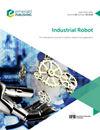基于局部POE的串联机器人高阶关节相关运动误差建模与标定
IF 2.5
4区 计算机科学
Q3 ENGINEERING, INDUSTRIAL
Industrial Robot-The International Journal of Robotics Research and Application
Pub Date : 2023-05-22
DOI:10.1108/ir-11-2022-0284
引用次数: 1
摘要
本文旨在解决传统Denavit-Hartenberg (DH)模型中典型的模型不连续问题。为了实现这一目标,我们建议使用局部指数积(POE)方法。此外,提出了一种同时考虑运动误差和高阶关节相关运动误差的修正标定模型。分析了运动误差和高阶关节相关运动误差,对模型进行了修正。机器人的定位精度在高速和重载制造应用中至关重要。在串联机器人标定中遇到的一个重要问题是传统方法只考虑拟合运动学误差,而忽略了与关节相关的运动学误差。采用slaguerre多项式拟合运动误差和高阶关节相关运动误差,在很大程度上避免了曲线拟合的龙格现象。利用Levenberg-Marquard算法对过参数化不敏感,能有效处理冗余参数,对修正后的模型进行快速标定。在一个机器人上进行了实验,验证了该方法的有效性;与切比雪夫多项式标定方法相比,定位精度由0.2301 mm提高到0.2224 mm。独创性/价值:结果表明,所提出的校准方法在工业串行机器人的绝对定位精度上取得了实质性的提高。本文章由计算机程序翻译,如有差异,请以英文原文为准。
Modeling and calibration of high-order joint-dependent kinematic errors of serial robot based on local POE
Purpose
This paper aims to address the issue of model discontinuity typically encountered in traditional Denavit-Hartenberg (DH) models. To achieve this, we propose the use of a local Product of Exponentials (POE) approach. Additionally, a modified calibration model is presented which takes into account both kinematic errors and high-order joint-dependent kinematic errors. Both kinematic errors and high-order joint-dependent kinematic errors are analyzed to modify the model.
Design/methodology/approach
Robot positioning accuracy is critically important in high-speed and heavy-load manufacturing applications. One essential problem encountered in calibration of series robot is that the traditional methods only consider fitting kinematic errors, while ignoring joint-dependent kinematic errors.
Findings
Laguerre polynomials are chosen to fitting kinematic errors and high-order joint-dependent kinematic errors which can avoid the Runge phenomenon of curve fitting to a great extent. Levenberg–Marquard algorithm, which is insensitive to overparameterization and can effectively deal with redundant parameters, is used to quickly calibrate the modified model. Experiments on an EFFORT ER50 robot are implemented to validate the efficiency of the proposed method; compared with the Chebyshev polynomial calibration methods, the positioning accuracy is improved from 0.2301 to 0.2224 mm.
Originality/value
The results demonstrate the substantial improvement in the absolute positioning accuracy achieved by the proposed calibration methods on an industrial serial robot.
求助全文
通过发布文献求助,成功后即可免费获取论文全文。
去求助
来源期刊
CiteScore
4.50
自引率
16.70%
发文量
86
审稿时长
5.7 months
期刊介绍:
Industrial Robot publishes peer reviewed research articles, technology reviews and specially commissioned case studies. Each issue includes high quality content covering all aspects of robotic technology, and reflecting the most interesting and strategically important research and development activities from around the world.
The journal’s policy of not publishing work that has only been tested in simulation means that only the very best and most practical research articles are included. This ensures that the material that is published has real relevance and value for commercial manufacturing and research organizations. Industrial Robot''s coverage includes, but is not restricted to:
Automatic assembly
Flexible manufacturing
Programming optimisation
Simulation and offline programming
Service robots
Autonomous robots
Swarm intelligence
Humanoid robots
Prosthetics and exoskeletons
Machine intelligence
Military robots
Underwater and aerial robots
Cooperative robots
Flexible grippers and tactile sensing
Robot vision
Teleoperation
Mobile robots
Search and rescue robots
Robot welding
Collision avoidance
Robotic machining
Surgical robots
Call for Papers 2020
AI for Autonomous Unmanned Systems
Agricultural Robot
Brain-Computer Interfaces for Human-Robot Interaction
Cooperative Robots
Robots for Environmental Monitoring
Rehabilitation Robots
Wearable Robotics/Exoskeletons.

 求助内容:
求助内容: 应助结果提醒方式:
应助结果提醒方式:


